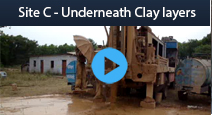Example Projects
The following pages depict some recent drilling projects with short descriptions which will help to understand the overall situation and the way our bore-well projects are conducted.
Project A, Spain
 Despite an absolutely negative geological and hydrological prognosis, we located two different water veins in this plot.
Despite an absolutely negative geological and hydrological prognosis, we located two different water veins in this plot.
The water vein that we accessed was at a depth of approx. 160 meters, under and within layers of sheer bed rock. As a result of the pressure within the vein the water rose by 115 meters within the borewell; i.e. it could be accessed at just 45m below surface.
Between this water source and the local ground water is a very large, extremely hard layer of granite which can be discerned in the picture from the rocks that were discharged by the drill. This means that it is impossible that any surface water, which may accumulate in some areas as ground water during rain intensive seasons, could have reached to the depth where the water was located!
Project B, Spain
 Another drilling project was conducted on a mountain that has literally no ground water at all. The water source was located at a depth of just 40 meters below surface and the water rose 34 meters within the bore-well, just by the pressure prevalent within the vain. The system, of which this vein is a part, is usually found in very irregular patterns and its veins often occur on mountains, where they can be found relatively close to the surface.
Another drilling project was conducted on a mountain that has literally no ground water at all. The water source was located at a depth of just 40 meters below surface and the water rose 34 meters within the bore-well, just by the pressure prevalent within the vain. The system, of which this vein is a part, is usually found in very irregular patterns and its veins often occur on mountains, where they can be found relatively close to the surface.
The drilling was conducted with a pressure drilling system which operates with a pressure of 30 bars and a drill with a diameter of 30.5 cm. In the upper, softer layers of soil and rocks, a plastic pipe was inserted during the drilling process, in order to prevent the drilled hole from possible crumbling and closing up. The actual deep drilling, starting with the onset of hard layers of rocks, was done with a drill of 20.5 cm diameter.
In such cases, the plastic pipe is then cut just below the soil surface and fitted with a removable lid. A revision pit is fixed for ease of access, and the pit is closed with an iron or concrete cover. With these fixtures in place one can easily maintain the bore-well, remove the submergible pump if needed and check electrical parts.
Project Begu, Eritrea
 The Begu valley is one of the most severe drought hit regions of the country. A geological and hydrological survey had been conducted by respective experts before the drilling project commenced and it was declared that no water could be found in the entire valley.
The Begu valley is one of the most severe drought hit regions of the country. A geological and hydrological survey had been conducted by respective experts before the drilling project commenced and it was declared that no water could be found in the entire valley.
Despite this the drilling exercise was conducted at the exact spot that had been identified as a result of the remote survey. To the utmost surprise of the local individuals present at the venue as well as the afore-mentioned geologists and hydrologists, water was struck at a depth of 115 meters. The perennial yield of this bore well is 7200 liters per hour.
Project Aznar, India
 The remote survey conducted for this site indicated the drill point right in between a dry open well (35 meter deep), a dried up hand pump (50 meter deep borewell) and another hand pump which gives only saline water (borewell depth of 55 meter); within a distance of less than 15 meters from each one of those existing wells.
The remote survey conducted for this site indicated the drill point right in between a dry open well (35 meter deep), a dried up hand pump (50 meter deep borewell) and another hand pump which gives only saline water (borewell depth of 55 meter); within a distance of less than 15 meters from each one of those existing wells.
Drilling was conducted to a total depth of 148 meters in order to utilise maximum possible water quantity; however water was already struck at a depth of just 30 meter below surface and the water level inside the well is at 15 meters. Especially the starting depth of the water (30 meter) astounded everyone present, given the presence of 3 nearby wells, all of which deeper than that, but without any potable water at all.
The well delivers 15,000 liters per hour (approx 360.000 Liter/Day) of drinking water; which means that this one well is enough to provide drinking water for the entire population of the village. The water was tested directly at the site as well as in certified laboratories and found to be of excellent drinking water quality.
Project Indore, India
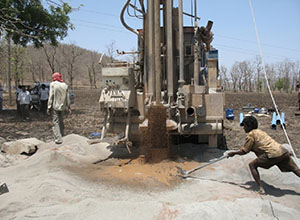 We were requested to find a water vein on a farming site about 40 km outside Indore. After we conducted our detailed remote survey, we pinpointed a drill spot in order to access a water vein. Over the years several hydrological and geological surveys had been conducted for this region and the conclusive results of them all are that this particular belt is severally water starved. Fact is that it is facing serious draught problems since more than 30 years and several nonfunctional bore wells of various depths are located within close proximity of the chosen spot.
We were requested to find a water vein on a farming site about 40 km outside Indore. After we conducted our detailed remote survey, we pinpointed a drill spot in order to access a water vein. Over the years several hydrological and geological surveys had been conducted for this region and the conclusive results of them all are that this particular belt is severally water starved. Fact is that it is facing serious draught problems since more than 30 years and several nonfunctional bore wells of various depths are located within close proximity of the chosen spot.
Drilling was commenced despite extreme weather conditions, further complicated by extreme dust coming out from the borewell throughout the drilling process; until the vain water was being accessed. In the photo one can see that until that moment only dry dust and material had come out. The vein was accessed at a depth of 151 meters; below 144 meters of layers of different kinds of hard rock and granite.
Project Haryana, India
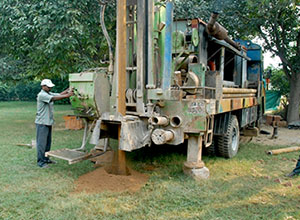 At this location groundwater is being found nearly everywhere and from very shallow depth (often starting from 4-5 meters onwards, down to 100, 150 and often deeper than that, but always with a very high TDS values, hence of none potable quality. Due to the presence of contaminated groundwater the main challenge was to construct a borewell which prevents the inflow/leakage of ground water into the well. This was done with a sealed casing all the way down to the depth where the vein starts. Here the water vein was found, and accordingly being accessed at a depth of 131 meters; the water is potable; the yield 235.000 liters per day.
At this location groundwater is being found nearly everywhere and from very shallow depth (often starting from 4-5 meters onwards, down to 100, 150 and often deeper than that, but always with a very high TDS values, hence of none potable quality. Due to the presence of contaminated groundwater the main challenge was to construct a borewell which prevents the inflow/leakage of ground water into the well. This was done with a sealed casing all the way down to the depth where the vein starts. Here the water vein was found, and accordingly being accessed at a depth of 131 meters; the water is potable; the yield 235.000 liters per day.
Project in Rajasthan Desert, India
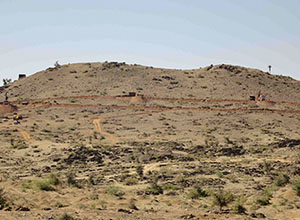 In this area of Rajasthan no agriculture of any kind takes place due to the absence of usable ground water. However, within 18 meters of the spot which had been identified for drilling, a water well existed wherein highly brackish water was found at a depth of 70 meters. Using this kind of water will ultimately lead to further diminishing the quality of soil, which will eventually lead to zero possibilities of vegetation of any kind. The water vein which was located here is a rather small, but as it is the only one on the entire plot we went ahead with the project and accessed it at a depth of exactly 60 meters. Sufficient potable water is now available for erigation purposes as was desired by the owner of this land.
In this area of Rajasthan no agriculture of any kind takes place due to the absence of usable ground water. However, within 18 meters of the spot which had been identified for drilling, a water well existed wherein highly brackish water was found at a depth of 70 meters. Using this kind of water will ultimately lead to further diminishing the quality of soil, which will eventually lead to zero possibilities of vegetation of any kind. The water vein which was located here is a rather small, but as it is the only one on the entire plot we went ahead with the project and accessed it at a depth of exactly 60 meters. Sufficient potable water is now available for erigation purposes as was desired by the owner of this land.
Project Orange County, Australia
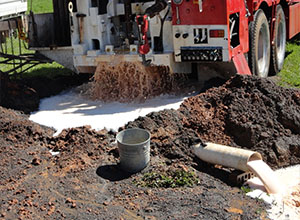 This region, approx 220 kilometer west of Sydney, has at times some rainfall, but during recent years far less than usual, and has therefore severe problems to locate reliable water resources. Even if a successful well can be established, it usually yields no more than 2-3,000 Liter/Hour, with decreasing or even ceasing quantities during dryer times of the year.
This region, approx 220 kilometer west of Sydney, has at times some rainfall, but during recent years far less than usual, and has therefore severe problems to locate reliable water resources. Even if a successful well can be established, it usually yields no more than 2-3,000 Liter/Hour, with decreasing or even ceasing quantities during dryer times of the year.
The borewell created at the spot identified via our remote survey has a stabile yield of 27.000 Liter per Hour!
Sample Videos
Sample Laboratory Test Report of Vein Water

In this sample test report it is of particular significance that the borewell is located in a belt where the ground water is prone to show very high levels of nitrate, as it is in an area with intense farming, where the overt application of chemical fertilisers has lead to large scale ground water pollutions. Despite this regional fact, the nitrate value of the vein water is blow 2!







